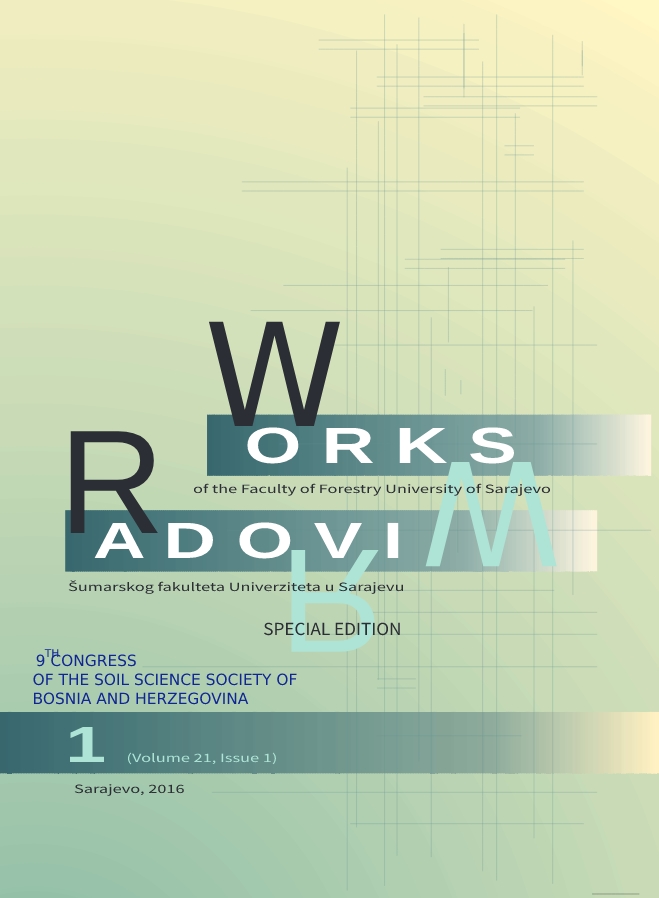LAND CAPABILITY STUDY AND MAP IN FUNCTION OF LAND PROTECTION, SPATIAL PLANNING AND AGRO-ECOLOGICAL ZONING
DOI:
https://doi.org/10.54652/rsf.2016.v1.i1.295Ključne riječi:
land capability, land protection, spatial planning, agro-ecological zoningSažetak
UDK 631.164(497.6)
The main act to consider the value of land from the perspective of various sectors and their needs (urban planning, agriculture etc.) in the Federation of B&H is the Decree on unique methodology for preparation of the spatial planning documents (Official Gazette of the Federation of B&H, No. 63/04 and No. 50/07), which prescribes the obligation of making the Land capability study as a segment of spatial basis. Land capability study projects are being implemented by the Institute of Soil, Agro chemistry and Melioration (PAM) of the Faculty of Agricultural and Food Sciences University of Sarajevo. By using defined soil bonity categories, land capability study defines the natural potential of soils in terms of agricultural production and food production, and defines the zones for various land use types. From the rational land use point of view, it means adequate spatial planning, urban development and environmental protection. This paper aims to present the importance, characteristics as well as use of the Land capability study at the municipality level using municipalities of Tuzla Canton as example. Agricultural areas of on the territory of five municipalities in Tuzla Canton (Gradacac, Gracanica, Kalesija, Zivinice, Sapna) account for 44,356.1 ha or 42.6% of the total area. Represented in these areas are soil bonity categories that range from II to VII. The first four bonity categories that are determined exclusively as agricultural land account for 28,739.91 ha or 63.1% of the total area. Within this group, the most represented is the IVb category with 17,229.8 ha. The best quality bonity categories II and III account for 7,514.3 ha or 16.5% of the total area. Analysis of the orthophoto images has identified a significant dynamics of change in space in the period 2008-2012 in four municipalities (Gradacac, Kalesija, Zivinice, Gracanica). Analysis has established that artificial areas (developed) increased by 737 ha, agricultural areas without orchards decreased by 1,136.72 ha, while the areas under orchards increased by 283.13 ha. The largest expansion of developed areas and settlements was recorded within the bonity categories IVb (47% of the total change) and III (27%).
Downloads
References
Bogunović Matko. 2009. Vrjednovanje zemljišta i racionalno koristenje prostora.Agronomski fakultet Sveučilišta u Zagrebu.
Bublin M. 2000. Prostorno planiranje. Univerzitetska knjiga, Studentska štamparija Univerziteta. Sarajevo.
Čustović H., Bajramović S. 2005. Državno zemljište kao potencijalni činilac poboljšanja posjedovne strukture u BiH. Uvodni referat na 32. Sajmu šljive, Gradačac.
Čustović H., Kovačević Z., Tvica M. 2013b. Ruralna ekologija. Sarajevo: Poljoprivredno-prehrambeni fakultet Univerziteta u Sarajevu.
Čustović H., Ljuša M., Marković M. 2013a. Land use changes and loss of soil in Bosnia and Herzegovina as consequences of the war and socio-economic transition, 2nd Scientific Conference UNCCD, Zbornik radova, 190-194.
Čustović H., Ljuša M., Taletović J., Tvica M. 2015. Application of land categorization in spatial planning of urban and suburban areas of Sarajevo. Növénytermelés (Crop production), Vol. 64, 131-135.
GAP. 2012. Politika u oblasti prostornog planiranja, Projekat upravne odgovornosti.
GEF i UNEP. 2014. Državni akcioni program za borbu protiv degradacije zemljišta i ublažavanja posljedica suše u BiH (NAP BiH). Sarajevo.
Izvještaj o napretku Nacionalne strategije održivog razvoja za 2012. godinu. Njemačka federalna vlada.
Kovačević P. 1992. Agronomski glasnik 4/1992. Pregledni članak. ISSN 0002 -1954 UDK 631.61
Ljuša M., Cero M., Čustović H. 2015. Promjena namjene poljoprivrednog zemljišta i funkcija tla u Bosni i Hercegovini u periodu 2000-2012. godina. Radovi Poljoprivredno-prehrambenog fakulteta, Univerziteta u Sarajevu, God. LX, broj 65/1, 7-16.
Ljuša Melisa. 2015. Trendovi i karakteristike promjena načina korištenja poljoprivrednog zemljišta u Bosni i Hercegovini. Disertacija. Poljoprivredno-prehrambeni fakultet Univerziteta u Sarajevu.
Loehr D. 2012. The Role of Tradable Planning Permits in Environmental Land Use Planning: A Stocktake of the German Discussion. Chapter 10.
Studija upotrebne vrijednosti zemljišta za područje općine Gračanica. Poljoprivredno- prehrambeni fakultet Univerziteta u Sarajevu. Sarajevo, 2013.
Studija upotrebne vrijednosti zemljišta za područje općine Gradačac. Poljoprivredno- prehrambeni fakultet Univerziteta u Sarajevu. Sarajevo, 2013.
Studija upotrebne vrijednosti zemljišta za područje općine Kalesija. Poljoprivredno- prehrambeni fakultet Univerziteta u Sarajevu. Sarajevo, 2014.
Studija upotrebne vrijednosti zemljišta za područje općine Sapna. Poljoprivredno- prehrambeni fakultet Univerziteta u Sarajevu. Sarajevo, 2015.
Studija upotrebne vrijednosti zemljišta za područje općine Živinice. Poljoprivredno- prehrambeni fakultet Univerziteta u Sarajevu. Sarajevo, 2014.
Tsenkova, S. 2005. Trends and Progress in Housing Reforms in South-Eastern Europe.Council of Europe Development Bank, Paris.
UN. 2008. Spatial Planning: Key Instrument for Development and Effective Governance with Special Reference to Countries in Transition. New York and Geneva.























